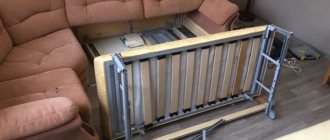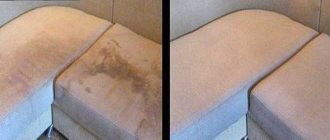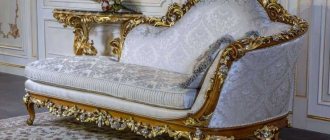Almost every pet lover has faced a similar question, because despite all the efforts of the owner to accustom the cat to the scratching post, she will still look for other places in order to test the strength of her claws, especially if the cat does not go outside. Often, a pet’s tendency to damage furniture is noticed quite late, when there are visible “traces of the crime” in the form of scratches and torn pieces of fabric.
Of course, it is necessary to carry out educational work with the cat, but this does not always help. So how can you restore a damaged sofa yourself and get by at low cost?
Methods for restoring leather furniture
There are several main ways to get rid of damage to leather furniture, which are used depending on the degree of damage to the product:
- using olive oil as a grout;
- application of “liquid skin”;
- applying a decorative patch.
How to restore a scratched sofa and what to do with the cat afterwards
Almost every pet lover has faced a similar question, because despite all the efforts of the owner to accustom the cat to the scratching post, she will still look for other places in order to test the strength of her claws, especially if the cat does not go outside. Often, a pet’s tendency to damage furniture is noticed quite late, when there are visible “traces of the crime” in the form of scratches and torn pieces of fabric.
Of course, it is necessary to carry out educational work with the cat, but this does not always help. So how can you restore a damaged sofa yourself and get by at low cost?
Oil grout
Using oil will help restore the covering of a leather sofa if the damage is not significant and the scratches are shallow and fresh. The grouting process does not present any particular difficulties. Use a cotton pad to gently rub the oil into the damaged areas and leave until completely dry. The procedure can be repeated if traces remain. For a better effect, you can iron the surface covered with a napkin with a low-heat iron. I would like to note that the iron should only be used for products made of genuine leather; repairing leatherette does not require heat treatment.
What to do with damaged leather upholstery?
A leather sofa or chair is a solid status part of the interior, which has a fairly high cost. Leather, under normal operating conditions, does not lose shape, does not fade, and retains its beautiful appearance for a very long time, unlike fabric upholstery. But the cat’s claws leave an “indelible mark” on it. How to remove cat scratches from a leather sofa and restore the original look of an expensive item?
We have collected a selection of proven tips and recommendations from people who have encountered a similar problem and achieved success in solving it. The choice depends on how large the scale of the disaster is.
Small, unnoticeable damage
How to repair a leather sofa from animal scratches using affordable means? There are several ways to disguise scratches and repair damage.
Glue
If there are any scratches left from your pet's claws, they can be glued back with glue. The glue, of course, must be designed for working with leather. Suitable:
- "Moment";
- “Rubber” (rubber) glue;
- Nairite.
Or something else, but by no means superglue. The packaging always indicates what surfaces it is intended for.
Here are some recommendations that will be useful to you when using this tool:
- Apply the glue carefully with a toothpick to the back of the hook, being careful not to get it on the front side.
- If you miss, wipe it off immediately, otherwise traces of glue will be noticeable.
- Then a piece of skin needs to be pressed to the place where it was. Run your finger firmly along the hook, moving from its base to its end, until it straightens and falls into place.
- After the glue has completely dried, treat the damaged areas with tinting leather cream. This will help completely disguise the scratched area.
Olive oil
You can try to get rid of shallow scratches using olive oil. The type of oil does not matter. This method is used even for light leather upholstery. In order to check how the sofa will “react” to olive oil, take a piece of leather that came with the sofa (responsible manufacturers usually put pieces of leather for patches) and rub the oil into it. If the test was successful, proceed to resuscitation of the sofa upholstery. Your actions:
- Apply a small amount of olive oil to the scratched areas using a cotton pad.
- Blot off excess and wait half an hour. Shallow scratches should smooth out.
- The manipulation can be repeated 2-3 times if the damage is a little deeper.
You can enhance the effect with heat. For this:
- Apply the oil to the desired area, place a cotton cloth or paper towel on top, and wait until the oil is absorbed.
- Then place a damp cloth on the treated surface and move a warm iron over it. Heat and water will help the oil penetrate better into the layers of the skin.
Important! The iron should be warm, not hot. And be sure to move it along the cloth, not leaving it in one place. The manipulation should take no more than 10 seconds.
Nail polish and marker
How to cover up scratches on a leather sofa? If there are few scratches and they are not very noticeable, but you need to get rid of them quickly and with the help of improvised means, then you can use nail polish of a suitable color. You can test whether it fits in an inconspicuous place or on a patch from the repair kit. Don't forget to consider the nature of the upholstery surface. If it is matte, then the varnish should also be matte, and vice versa. It is important to apply the strip of varnish exactly along the scratch, without going beyond it, so it would be better to use a thin brush, a toothpick or a pointed match.
Similarly, you can quickly veil a scratch with a marker of a suitable shade.
For a better effect, you can then walk over the surface of the damaged area with leather cream (you can use shoe cream).
Special wax
Wax can also help fill damaged areas on leather upholstery, only a special one - for leather or bee wax. It's easy to work with. The wax is slightly heated until it becomes soft, and then rubbed into the desired areas with a flannel scrap.
Shoe polish and leather dye
Shoe polish or leather paint can also help disguise mechanical damage to leather upholstery. Manipulations with shoe polish are simple: apply the product to a cotton pad or soft cloth and rub into the scratches. Leather paint is easier to apply with a soft brush.
Probably the biggest problem for owners of colored sofas and armchairs is choosing the right shade, because not all shoe stores have the entire palette of shades. Alternatively, you can try mixing two colors, you may be able to achieve the desired shade.
All these methods are also good if the cat scratches the leatherette sofa.
Visible and significant damage
If there are a lot of scratches, then it will be easier to disguise the damage using other available means.
Liquid skin
This composition, reminiscent of gouache in consistency, is sold in sets of several colors or individually. It's easy to use. If your furniture is a non-standard color, you will have to buy several of the desired colors in order to achieve the desired shade by mixing.
How to proceed to get rid of scratches on a leather sofa:
- Apply the composition with a brush or a piece of foam rubber in several layers.
- Press the sponge onto the wet surface to give relief.
Liquid skin wonderfully masks “moderate” damage.
Patches and applications
If the damage is large-scale and noticeable, then you will have to take more radical methods. Damaged areas of the upholstery will have to be covered with patches:
- It makes sense to place patches in inconspicuous places, for example, at the bottom of the sofa. They are glued on using a special leather glue, and then liquid leather can be applied on top to hide the edges of the patch.
- If the armrest turns out to be torn, then it makes sense to replace the upholstery on this part, choosing the desired leather color. It will be easier to turn to specialists for this, although you can try to do the work yourself.
- If your interior style is conducive to this, you can disguise the damaged areas with appliqué. To do this, cut out patches of the desired shape from leather of a contrasting color (abstraction, geometry, flowers, etc.) and stick them where necessary. It should look like a composition, so fragments can be placed both on scratched places and on whole ones.
If patches and appliques do not suit you, then the following options remain: reupholstering furniture or stretching a cover for a sofa. The second one will cost much less.
As you can see, the problem is not so critical, of course, if the cat has not torn off the entire sofa. From now on, start weaning your pet from this habit, or rather, transfer his attention to a special scratching post, and continue to live in peace and comfort with your furry and all the furniture.
Share on social media networks:
Application of “liquid skin”
“Liquid skin” will help cope with more serious damage. It comes in a convenient aerosol form. Before use, it is advisable to clean the area of furniture from dirt and degrease it. Apply the liquid in an even layer and cover with a cloth, after which it is also recommended to warm up the area with a warm iron. This type of repair allows you to disguise fairly large scratches.
Saving a sofa with oil
Wet the sofa with oil and then polish it well
If the scratching post was not purchased on time, and the pet managed to get to the leather sofa, sharpening its claws on it and leaving scratches, read about how to save the furniture. For restoration work you need to stock up on the following supplies.
| Oil | Tampons | With a rag |
| For wetting | For wiping | For polishing |
- You can wipe a very small damaged area of leather on the surface of the furniture.
- Check carefully for any changes to the upholstery. If no changes are found, wipe the cat's scratches and the areas surrounding them.
- Using a rotating motion, rub the oil into the sofa. You will need to wait half an hour and see what you get.
If the cat scratched the sofa shallowly, the traces of the cat’s crime will disappear after the first manipulation with the oil. But if the traces lie deeper than expected, the steps described above will have to be repeated three to four times.
Sofa seat damaged by scratches before and after repair
Patches and applications
What to do if the furniture is not just scratched, but also torn to shreds? The most basic option is reupholstery, but this is not always available, so patches or appliques can help out in this situation. You can use a patch on inconspicuous places on the sofa. It is recommended to glue it with special furniture glue or sew it on.
But if the back, seat or armrests of the sofa are damaged, you cannot do without an application. In this case, you can use pieces of leather fabric that contrasts the color of the sofa. From them we cut out various shapes that suit the decor in your room, and stick them not only on damaged areas of furniture, but also as decoration.
Why do cats have a passion for upholstered furniture?
Before you figure out how to stop a cat from tearing up furniture, you need to justify this behavior of your pet to yourself. The animal is partial to upholstered furniture and wallpaper because:
- Follows instincts. Claws are the main defense of cats in the wild. To hunt and survive, they need to hone their claw skills. Now Barsik no longer obtains his own food, but thousands of years of evolution are not easily forgotten.
- Sharpening his claws. People file their nails with a nail file, dogs sharpen their claws while running on a hard surface, and in order for a cat to get their claws in order, they need to stick them as deeply as possible into the hard surface and drag them across it with force. Dead claw scales remain on the upholstery, and new ones form in their place.
- Stretching. You've probably noticed how the purr elegantly arches its back and stretches. At this time, he likes to move his paws, ruining the upholstery.
- Relieves tension. Sometimes a cat kills the sofa upholstery very carefully. She takes out aggression in this way when she is angry or upset.
- Marks territory. Cats have scent pads at the base of their paws. While scratching, the pet marks the object with its individual scent.
When we have decided that it is vital for a fluffy to sharpen its claws, we should consider how to wean a cat from tearing furniture and wallpaper.
How to stop a cat from scratching furniture?
A separate issue is raising your animal. How to stop him from sharpening his claws on your furniture? You can purchase a special liquid at a veterinary store that repels cats. This composition should be used to saturate the furniture in those places where the cat likes to misbehave. There is also a composition that, on the contrary, attracts the cat’s attention, and it needs to be applied to the scratching post. Well, most importantly, devote more time to your pet, maybe he is just trying to attract attention with his pranks.
What do you think? Maybe you have your own ways to save your favorite furniture?
Why do cats tear up furniture?
First of all, it must be said that the desire to sharpen claws is determined by physiological characteristics, regardless of what breed the pet has. Itching appears in the pads of the limbs, which causes animals to scratch their claws. The unpleasant sensation is associated with replacing the old plate with a new one. At the same time, owners may often notice that burrs appear on the pads, which also cause inconvenience to the cat.
An equally common reason is the fight for territory. Sweat glands are located on the limbs, which, when in contact with surfaces, leave a pet's aroma. In addition, when sharpening claws, all muscle groups are involved, thus keeping cats in good shape. An animal can also tear up furniture in order to get rid of stress. Sharpening claws is also an excellent option for attracting the owner's attention.











